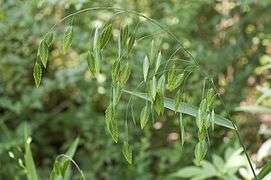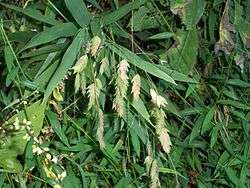Chasmanthium latifolium
Chasmanthium latifolium, known as woodoats, inland sea oats, northern sea oats, and river oats is a grass native to the central and eastern United States, Manitoba, and northeastern Mexico; it grows as far north as Pennsylvania and Michigan,[1] where it is a threatened species.[2] The species was previously classified as Uniola latifolia (André Michaux).
| Chasmanthium latifolium | |
|---|---|
 | |
| Chasmanthium latifolium | |
| Scientific classification | |
| Kingdom: | Plantae |
| Clade: | Tracheophytes |
| Clade: | Angiosperms |
| Clade: | Monocots |
| Clade: | Commelinids |
| Order: | Poales |
| Family: | Poaceae |
| Genus: | Chasmanthium |
| Species: | C. latifolium |
| Binomial name | |
| Chasmanthium latifolium (Michx.) Yates | |
Description
Chasmanthium latifolium is a cool-season, rhizomatous perennial grass with stems about 1 m [3 feet] tall.[3] The plant typically grows in wooded areas and riparian zones.[4]
Gardens

It is used in landscaping in North America, where it is noted as a relatively rare native grass that thrives in partial shade; the plant is recommended for USDA hardiness zones 3–9 in acidic sands, loams, and clays.[5][6]
References
- Kew World Checklist of Selected Plant Families
- "Chasmanthium latifolium (Indian Woodoats)". Global Biodiversity Information Facility. Retrieved 2010-07-08.
- Navarrete-Tindall, Nadia (Summer 2010). "Native Cool-Season Grasses in Missouri". Missouri Prairie Journal. 31 (2): 20–25.
- "PLANTS Profile for Chasmanthium latifolium (Indian woodoats)". PLANTS database. United States Department of Agriculture. Retrieved 2010-07-08.
- "Northern Sea Oats - Ornamental Grasses - University of Illinois Extension". University of Illinois.
- "NPIN: Chasmanthium latifolium (inland sea oats)". Native Plant Information Network. University of Texas. Retrieved 2010-07-08.